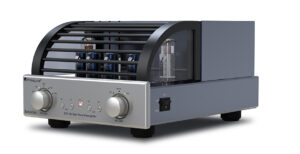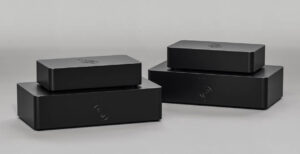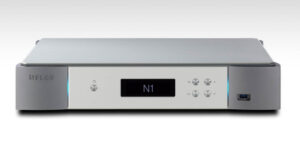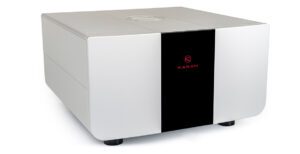
More than a year ago Hi-Fi+ favourably reviewed Moon by Simaudio’s superb Neo 430 HAD headphone amp/preamp/DSD DAC and found it to be a world-class product—one even the most particular headphonistas could happily embrace as a benchmark component. In practical terms, the only drawback with the Neo 430 HAD was that its £3,800 asking price placed it beyond reach for a number of otherwise passionate and sound quality-conscious headphone enthusiasts. What was needed, some thought, was a headphone amp/DAC similar in overall sonic characteristics to the 430HAD, but that would sell for a more manageable price. Happily, Moon by Simaudio had this very idea in mind when they created the Neo 230HAD headphone amp/DAC, which sells for £1,500.
How did Moon by Simaudio achieve such a dramatic reduction in price without cutting significant sonic corners? As is always the case in such design plans, the answer lies in deciding exactly where and how acceptable compromises can be made. If we take the original 430HAD as a starting point, then here are the cost-reducing changes Moon implemented in developing the 230HAD.
First, Moon decided that unlike the 430HAD, which features a fully balanced amplifier, the 230HAD instead would incorporate a single-ended only amplifier. Along with this decision came a concomitant choice to roll back the 230HAD’s power output specifications to what might be described as a ‘moderately powerful’ level—this in contrast to the 430HAD’s prodigious 8 Wpc (!) output capabilities.
Second, Moon elected to scale back the size (though not the quality) of the 230HAD’s power supply, which in turn meant the 230HAD’s circuitry could fit within a half-width chassis as opposed to the full rack-width chassis used for the 430HAD.
Finally, Moon utilised a traditional high-quality motorised-Alps volume potentiometer, in contrast to the sophisticated optical encoder-controlled 530-step attenuator of the 430HAD, which was itself derived from the company’s Evolution-Class products. The use of a potentiometer is a significant cost saving, even if it comes at the expense of the stepped attenuator’s ultimate transparency and ability to maintain tight inter-channel balance.
Taken together, these choices made good sense in that the sensitivity ratings of many top-tier headphones have steadily been climbing in recent years, meaning that as a rule there is less of a premium on sheer headphone amp power output than there used to be. The one potentially significant trade-off, though, is that the 230HAD’s 115dB signal-to-noise ratio is not as good as the 430HAD’s tomb-quiet 120dB signal-to-noise ratio—a difference partly attributable to the single-ended vs. fully-balanced circuitry of the two models, but also attributable (I suspect) to the 230HAD’s somewhat less beefy power supply.
On the digital audio side of things, it appears the 230HAD and 430HAD use similar if not identical DAC sections. The DAC sections of both units can handle PCM files at 16-32 bits/44.1 – 384kHz, and can decode DSD64, DSD128, and DSD256 files. Quoted frequency response, bandwidth, and distortion figures for the two units’ DAC sections are essentially the same, which is good news for prospective 230HAD buyers.
Then, as a final cost-reduction measure, Moon has configured the 230HAD so that it deliberately eliminates all non-essential features from the 430HAD, thus making the ‘junior’ model as simple and affordable as possible. For example, where the 430HAD had user-adjustable master gain settings and provided built-in user-selectable crossfeed circuitry (designed to provide a more three-dimensional, outside-the-head listening experience for headphone users), the 230HAD foregoes both features. Likewise, where the 430HAD sported extensive home automation-orientated features such as a 12V trigger output, an IR sensor, an RS-232 control port, and Simaudio’s SimLink system, the light and lithe 230HAD omits all of the above.
In theory, either the 430HAD or the 230HAD can be used as primary preamplifier/DACs in speaker-based hi-fi systems. In practice, though, it’s clear the 430HAD stands more as the versatile, audio rack-mountable, full-featured preamp/DAC/headphone amplifier, whereas the 230HAD presents itself as the streamlined, ‘everything-you-need-and-nothing-you don’t’ desktop model that likely will be used primarily for headphone listening.
With that said, however, here is an interesting factoid to consider. If you compare the performance specifications of the 430HAD and 230HAD side by side, you will discover that—apart from noise and power output specifications—the two units appear virtually identical. On paper, then, it would seem the 230HAD and 430HAD share a significant amount of sonic ‘DNA’, despite the obvious differences between the two. But this raises a key question: Are these seeming similarities borne out in real-world listening tests? In a word, yes, they are.
For my tests, I fed the 230HAD a mix of standard (16/44.1) and higher-res PCM and DSD music files from a Windows/jRiver-based music server, while listening through four sets of very high-performance headphones: the ENIGMAcoustics Dharma D1000, the Focal Utopia, the HiFIMAN HE1000 v2, and the MrSpeakers ETHER Flow. Here is what my listening sessions revealed.
First, I learned that Moon by Simaudio isn’t kidding around when it recommends giving the unit roughly 300 hours of run-in time before listening critically. Straight out of the box the 230HAD sounds good (but not great), initially exhibiting an opaque sound somewhat lacking in transparency and nuance. But as the hours accumulate, the 230HAD’s sound dramatically improves. Resolution of low-level details increases, tonal colours become more vibrant and fully fleshed-out, transient speeds and overall definition get better, and dynamic agility and expansiveness take big steps forward. In short, proper run-in helps the 230HAD be all that it can be.
Once broken in, the 230HAD serves up a hearty, vigorous, and expressive sonic presentation that centres upon, and is built around, a well developed, open-sounding midrange. There is the sense, always, that the 230HAD is capturing the energy and vitality inherent in good recordings and conveying these qualities with appropriate (but never exaggerated) verve. There are excellent levels of midrange, upper midrange, and treble detail as well, though it is that overriding quality of ‘aliveness’ that consistently catches and holds the listener’s attention.
These qualities are never more apparent than on intimate, well-recorded vocal tracks, such as Eva Cassidy’s live performance of the blues standard ‘Stormy Monday’ from Live at Blues Alley [Blix Street, 16/44.1] where the 230HAD—driving Focal’s superb Utopia headphones—creates the uncanny illusion that Cassidy is standing only a few feet away from the listener as she performs (in fact, the illusion so vivid that one almost wants to stand up and start clapping at the end of the song). Every small shift in inflection, every pause for breath, and every burst of vocal energy—whether large or small—become not just audible (in the usual hi-fi sense), but more importantly sounds gloriously vibrant and alive. This is the sound of the 230HAD at its best.

Similarly, listen to the sound of Miles Davis’ trumpet as he and his backing band offer their striking rendition of Cyndi Lauper’s ‘Time After Time’ on Davis’ Live Around the World [Warner Bros., 16/44.1]. The 230HAD enables great headphones to showcase Davis’ deft, subtle command of instrumental textures and timbres and also to show how Davis uses his trumpet’s very wide dynamic range for dramatic effect, with passages that range all the way from the whisper-quiet range on up into moments of full-throated expression. As in the Eva Cassidy record cited above, the 230HAD again captures a quality of musical intimacy on ‘Time After Time’, so that you not only hear but also feel the interactions between the musicians as they make individual contributions. For example, the performance of the electric bassist on the familiar (and downright infectious) bass riff from the song’s chorus, is at once a fine musical statement in its own right, but also the rhythmic engine that gently but firmly pulls the song forward. At every turn, the 230HAD shows the listener—in both intellectual and emotional terms—how the dynamics of songs are meant to work.
When it comes to the matter of detail, I would say that if you heard the 230HAD (again, after run-in is complete) in isolation you might rightly think it to be one of the more resolving headphone amplifiers on the market. However, if you were to do a side-by-side comparison with the more expensive 430HAD it would become apparent that the 230HAD’s bigger brother could dig down just a smidgeon deeper into the innermost aspects of fine recordings. There is no shame in this, though; the 230HAD does a great job for its size and price. Just be aware that if you want to push the performance envelope as hard as possible, the 430HAD might be the better choice.
In terms of overall voicing the 230HAD and 430HAD are very similar, though my instinct is that the 230HAD is perhaps every so slightly warmer sounding and thus just a bit more forgiving when it comes time to play less than ideal recordings (especially ones with a characteristically bright sound). Bass capabilities of the two amps are likewise similar (within the power output constraints of the 230HAD), though when push comes to shove the 430HAD offers perhaps a touch more grip and pitch definition, plus ‘bottomless pit’ reserves of low-end power. In contrast, the low end of the 230HAD consistently sounds energetic, with great pace and drive, but with the constraint that—when pushing very low sensitivity headphones—the 230HAD could potentially reach a point where it might run out of steam. (This never actually happened with the relatively high-sensitivity reference headphones I had on hand, but with low sensitivity headphones such as the Abyss AB-1266 or HiFiMAN’s new Edition 6, I suspect it could be a problem).
All in all, the 230HAD fulfils its mission brilliantly. It is a highly accomplished headphone amp/preamp/DAC that conveys much of the overall sound and feel of Moon by Simaudio’s flagship 430HAD, but for a fraction of the price. For those who want a big taste of what top-tier headphone amp/DACs are all about, yet without paying a full on, top-tier price, the 230HAD is worthy of serious consideration.
TECHNICAL SPECIFICATIONS
Type: High-resolution desktop headphone amplifier/DSD DAC
Inputs: One TOSLink optical digital input, two coaxial S/PDIF digital inputs, one USB input (32/384 and DSD256-capable), two single-ended stereo analogue inputs (one via stereo RCA jack, one via 3.5mm mini-jack)
Outputs: One single-ended headphone outputs (one via a 6.35mm headphone jack), and two stereo analogue outputs (one fixed level and one variable level, both via RCA jacks)
Device drivers: PC will support up to 384kHz sample rates and DSD64/ 128/256 with installation of a Moon‑supplied “USB HD Driver”.
Frequency Response:
Amplifier: 20Hz – 20kHz ± 0.1dB, 5Hz – 100kHz +0/-3.0dB
DAC: 20Hz – 20kHz ± 0.2dB, 2Hz – 72kHz +0/-3.0dB
Signal-to-Noise Ratio:
Amplifier: 115dB @ full output, 20Hz – 20kHz
DAC: >114dB @ full output
Distortion:
Amplifier: THD, 20Hz–20kHz, 0.005%. IMD, 0.005%
DAC: THD @ 1kHz, 0dBFS (A-weighted), 0.001%. IMD, 0.004%
Power Output: 600 Ohms, 100mW, 300 Ohms, 200mW, 50 Ohms, 1 Watt
Dimensions (H×W×D): 178 × 76 × 280mm
Weight: 2.8kg
Price: £1,500
Manufacturer: Simaudio Ltd.,
URL: www.simaudio.com
Distributed by: Renaissance Audio Ltd
URL: www.renaissanceaudio.co.uk
Tel: +44(0) 131 555 3922
Tags: FEATURED
By Chris Martens
More articles from this authorRead Next From Review
See all
PrimaLuna EVO 100 phono preamplifier
- Apr 22, 2024

Reiki Audio SuperSwitch Master Pro + Servant Pro
- Mar 27, 2024

Melco Audio N1-S38 music server
- Mar 27, 2024











